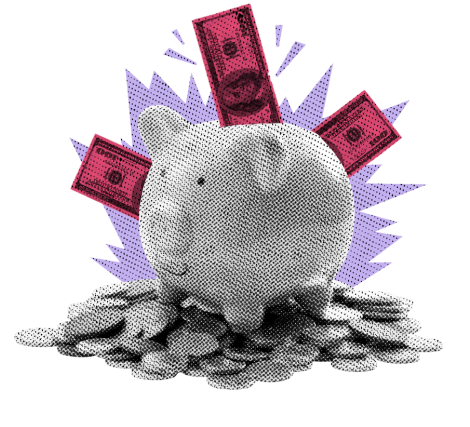
Are we ignoring warning signs in the economy? The labor market is cooling, and the Fed may be too slow to act.
KEY TAKEAWAYS
- The labor market is cooling, with layoffs increasing and hiring slowing.
- Trade policy uncertainty is weighing on corporate decision-making, likely leading to more cautious hiring.
- Economic data is a lagging indicator, meaning problems today won’t show up in reports for months.
- Inflation remains above the Fed’s 2% target, but history suggests that 2% is arbitrary.
- The Fed is reactive, not proactive, which could mean trouble if the economy weakens further.
MY HOT TAKES
- The labor market is slowing, but the worst is yet to come. Layoffs in DC are only starting, and corporate job cuts are increasing. The next 6 months don’t look great.
- The Fed is waiting for data that will already be outdated when it arrives. Reacting instead of acting is a dangerous game in this market.
- The 2% inflation target is arbitrary. It’s a made-up number based on 1989 New Zealand policy. Historical inflation has been much higher—why are we still pretending 2% is the magic number?
- Tariffs are inflationary. Period. The Fed can’t ignore a 25% permanent price increase just because it’s labeled “transitory.”
- Markets are resilient, but cracks are forming. Consumer confidence is slipping, spending is declining, and CEOs are getting cautious. If Powell waits too long, things will break before they get fixed.
The woods beyond the woods. Are you trying to get your bearings? Haven’t we passed that fallen tree already? Does it feel like we are going in circles? When are we going to get out of this forest? I know, we can look up at the sun and try to figure out which way we are headed. The treetops are unfortunately blocking our view, making it hard to glean the azimuth of the sun. There it is, I got your heart racing, didn’t I?
Now that we are all warmed up, let’s get down to business. Friday’s monthly employment number wasn’t terrible, but it wasn’t great either. There are some signs that the labor market is cooling. First, the pace of hiring has slowed somewhat. This release has not fully factored in a lot of the DOGE job-cutting in DC; remember that many folks took packages which essentially deferred their unemployment, and more cuts are planned. Additionally, we have not yet seen the wave of unemployment that will come from federal contractors in response to the many publicly-paraded contract cancellations–they will come, trust me. Additionally, and anecdotally, we have been hearing more and more about job cuts in the private sector ( HP, Meta, Starbucks, Ford, Estee Lauder, etc).
What about the pace of hiring? Given the recent injection of uncertainty by the unclear and wildly swinging trade policy, CEOs are likely starting to consider more “conservative” spending policies until they get more clarity. As clarity does not appear to be forthcoming any time soon, it is likely that companies will slow their hiring, which will also pressure labor markets. In other words, the labor market, at the moment, appears to have more downside than upside, certainly over the next 6 months. Or, if you want me to be more optimistic, it will probably get better… but not before it gets worse.
So, what does that mean for us… today? Well, on Friday, equities looked like they were going to close out a tough week on a tough note falling in the wake of prior session’s trade war fears and the soft employment figure. Later in the session, Fed Chair Jerome Powell said, “despite elevated levels of uncertainty, the US economy continues to be in a good place.” Ok, “finally a calm voice of reason in the recent sea of policymaker chaos,” thought the market as it applauded the Chair by closing in the green. 👏
That left me wondering. I have recognized that the economy, and indeed the market, has been holding up well despite all the uncertainty that has emerged in the past several weeks. Sure, markets have been volatile, but they have held their own considering. The economy has been throwing some pretty positive numbers recently, though, by my estimate, some wrinkles appear to be showing. Namely, the recent decline in consumer confidence and personal spending. And it is important to remember that the most highly followed economic numbers tend to be lagging indicators. Indeed, even corporate earnings, which we focus quite a bit on, are technically lagging numbers, telling us how well our portfolio companies did at the end of last year. The point here is that trouble brewing today will not show up in the economic numbers for at least 3 - 6 months. Stay with me, I am going somewhere with this.
The Fed, by its own admission, is data dependent. In other words, they will act… um, react when it sees the numbers–the data. Under normal circumstances, that might be ok, but I would posit to you that by the time any data shifts occur in this very-lively (😉 ) market, a reaction may be too late to prevent things from getting worse yet.
I decided to dig a little deeper into Powell’s comments from Friday. To start, Powell toed the line with a “we do not need to be in a hurry.” He acknowledged that uncertainty is high, though that is not his problem. He also acknowledged that recent indicators suggest that spending may moderate.💥 You know that got me. Spending has moderated and it may continue to moderate. That is bad for economic growth. But economic growth, you see, is not part of the Fed’s mandate which includes only inflation and employment.
Starting with the latter, what would cause the already cooling labor market to get cooler. Well, how about MODERATED SPENDING! So, indeed that can be a problem for the Fed. If companies are making less money because consumers are holding on to their cash, a company is faced with a tough decision: accept lower earnings or cut expenses to make up for lost revenue. Which do you think they will choose?
Now, on to inflation. Am I the only person that heard both the CEOs of Target and BestBuy warn outright, just last week, that prices to consumers will go up due to tariffs. Please, my friends, don’t be fooled. Prices will go up if tariffs stand. Transitory or not, prices will go up. If we are playing math games and call the move “transitory” as the Treasury Secretary did last week in a speech, let’s do the math. That one-time bump that will happen as televisions, wash machines, and a bunch of other stuff will register as inflation, calculated year over year, for… um, a year. It’s just math, stupid. Do you think that the Fed can tolerate inflation being elevated for a year waiting for the base effect to kick in? I don’t think so, and by the way that stuff is going to cost at least 25% more… forever!
Now, I know that inflation is coming down slowly, and we will get another read of that this week with the release of Consumer Price Index / CPI, but inflation is still not where the Fed wants it to be–at its 2% target. In this past month, Fed-talk has largely been something like “we are in no rush, inflation still needs to improve more.” We are now in a blackout period leading up to next week’s FOMC meeting. Fed Futures give us a 4% chance of a rate cut, which on Wall Street means “nope.” Futures give us the first likely chance of a cut in June. I agree that the Fed will not likely lower rates next week or even when the FOMC meets in May, but that doesn’t mean I agree.
Did you ever wonder how the Fed came up with its 2% target? You are probably thinking that there is a fancy math rule or something. But there isn’t. Do you know that the Reserve Bank of New Zealand was the first central bank to come up with a target inflation rate? It did in 1989, and it was 0 - 2%. Hmm. The UK and Canada soon began to use a target rate. In the 1990’s the Greenspan Fed did not have an explicit target, but it was assumed to be in the 2% range. It wasn’t until 2012 that Chairman Bernanke made 2% the official target. Where did he come up with that target? The country was still in the wake of the Global Financial Crisis. Do you know what the average core CPI was in 2008 through 2012? It was 1.7%, so 2% seems reasonable right? If we extend to the start of 2021, the average core CPI was 1.87% also making 2% seem reasonable.
So, is it wise to be so attached to the concept? Is 2% really a smart target? Perhaps we should look further back and see where inflation has been over a longer period of time, say, back to 1958 when the Bureau of Labor Statistics first started calculating Core CPI. Since then, Core Inflation has run at 3.7% on average, and headline inflation (including food and energy) ran at 2.87% since 1920. On Wednesday, we will get the latest read on inflation, and economists are expecting Core and Headline CPI to come in at 3.2% and 2.9% respectively. Both still far away from the Fed’s made up 2% target, but darned close to the long-running averages. Would it be too much to expect the Fed to possibly be proactive instead of reactive?
FRIDAY’S MARKETS
Stocks bounced about in a seesaw session giving up early losses on trade fears, closing in the green after the Fed Chair calmed nerves praising the economy. Labor numbers were slightly weaker than expected but good enough to avoid fear of a meltdown. Hourly earnings grew by 4.0 year over year showing that wage growth is keeping up with inflation.

NEXT UP
- No major numbers today, but later in the week we will get some last-minute earnings stragglers as well as JOLTS Job openings, Consumer Price Index / CPI, Producer Price Index / PPI, weekly employment figures (because traders are watching 👀) and University of Michigan Sentiment. Download attached calendars for times and details.
- Earnings today: Vail Resorts and Oracle.
DOWNLOAD MY DAILY CHARTBOOK HERE 📊
.png)

